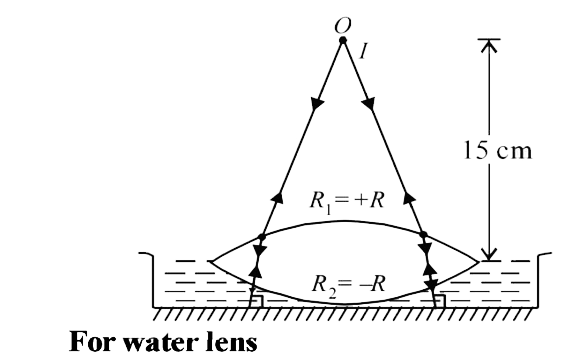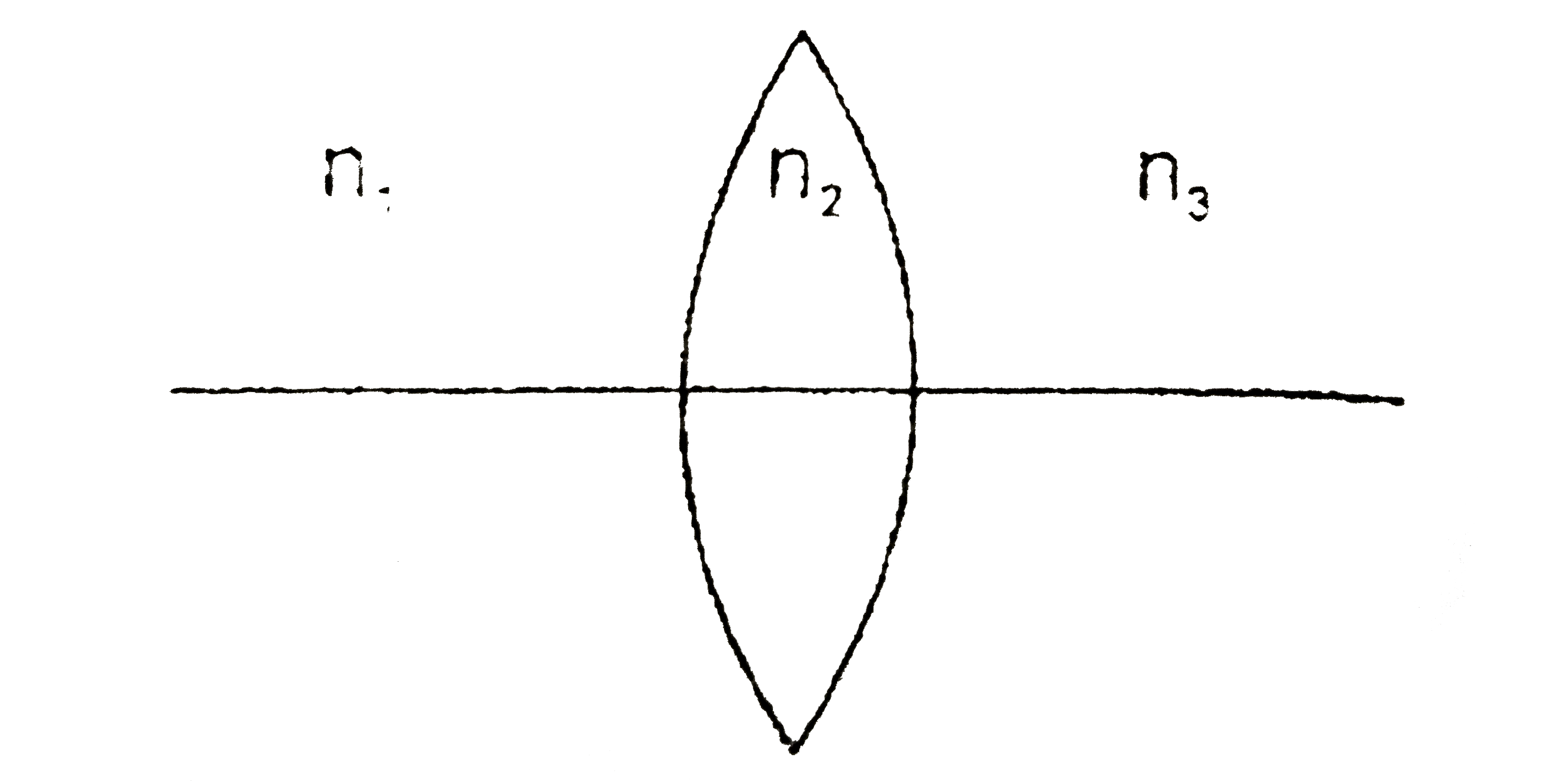A thin equiconvex lens of refractive index 3/2 is placed on a horizontal plane mirror as shown in figure. The space between the lens and the mirror is filled with a liquid of refractive index 4/3 . It is found that when a point object is placed 15 cm above the lens on its priincipal axis, the object coincides with its own image.

Q. If another liquid is filled instead of water, the object and the image coincide at a distance 25 cm from the lens.
Calculate the refractive index of the liquid.
The correct Answer is:A

The lens makes formula is
1f=(μ−1)(1R1−1R2)
When the space between the lens and the mirror is filled with water, a system of two lenses is formed.
(i) a glass lens
(ii) a plano concave water lens
For glass lens Here R1=+R and R2=−R 1fe=(1.5−1)(1R−1−R)=1R
For water lens
1fw=(1.33−1)(1−R−1−∞)=−0.33R
The focal length of the combination of two lenses will be
1f=1f1+1f2=1R−0.33R=0.67R...(ii)
A convex lens placed on a plane mirror behave like a concave mirror. The image is formed at the object itself if the object is placed at centre of curvature of concave mirror. After refraction through lens, the rays fall on the plane mirror normally and retrace their path to form image at the oobject itself.
∵ Focal length of system(f)=15cm...(ii)<br>From(i)and(ii)<br>(1)/(15)=(0.67)/(R)impliesR=10.05cm<br>Thesamesituationisrepeatedwithtwod⇔erences<br>(a)Theobjectandima≥distanceareno25cmand<br>(b)Inplaceofwaterthereisa≠wliqufretion∈dexmu<br>Aga∈(1)/(f_e)=(1)/(R)and(1)/(f^())=−(μ−1)R where f isthefocal≤n>hof≠wliquns.:'Newcomb∈ed≤ns,<br>(1)/(F)=(1)/(f_l)+(1)/(f^)=1R−+(μ−1)R=1−μ+1R=2−μR ...(i)
For new combined lens,
∵1F=125
From (i) and (ii)
2−μ10.02=125 ∵μ=1.6
Topper's Solved these Questions
Similar Questions
An equiconvex lens of refractive index μ2 is placed such that the refractive :

View SolutionA thin bi-convex lens made up of glass of refractive index 3/2 is placed is front of a plane mirror. The space between the lens and the mirror is filled with water of refractive index 4/3 . The radii of curvatures of the lens are R1=15cm and R2=25cm . A point object is placed at distance x from the surface whose curvature is R1. The distance x is greater than the separation between the lens and the mirror. Find the value of x so that image must coincide with the object.
View Solution
Knowledge Check
A thin equiconvex lens of refractive index 3/2 is placed on a horizontal plane mirror as shown in figure. The space between the lens and the mirror is filled with a liquid of refractive index 4/3 . It is found that when a point object is placed 15 cm above the lens on its priincipal axis, the object coincides with its own image.

Q. The radius of curvature of the convex surface isA10cmB15cmC20cmD25cmA thin equiconvex lens of refractive index 3/2 is placed on a horizontal plane mirror as shown in figure. The space between the lens and the mirror is filled with a liquid of refractive index 4/3 . It is found that when a point object is placed 15 cm above the lens on its principal axis, the object coincides with its own image.

Q. If another liquid is filled instead of water, the object and the image coincide at a distance 25 cm from the lens.
Calculate the refractive index of the liquid.A1.6B3.2C0.8D2An equiconvex lens of refractive index n2 is placed such that the refractive index of the surrouding media is as shown. The lens :
 Amust be diverging if n2 is less than the aritmetic mean of n1 and n3Bmust be converging if n2 is greater than the arithmetic mean of n1 and n3Cmay be diverging if n2 is less than the arihmetic mean of n1 and n3Dwill neither be diverging nor converging if n2 is equal to arithmetic mean of n1 and n3
Amust be diverging if n2 is less than the aritmetic mean of n1 and n3Bmust be converging if n2 is greater than the arithmetic mean of n1 and n3Cmay be diverging if n2 is less than the arihmetic mean of n1 and n3Dwill neither be diverging nor converging if n2 is equal to arithmetic mean of n1 and n3
On a horizontal plane mirror, a thin equiconvex lens of glass is placed and when the space between the lens and mirror is filled with a liquid, an object held at a distance D which is 30cm vertically above the lens is found to coincide with its own image as shown in Figure. If equiconvex lens of glass has refractive index μ=1.5 and radius of curvature R=20cm then find refractive index of the liquid.

View SolutionAn equi-convex lens, having radius of curvature 33 cm is placed on a horizontal plane mirror and a pin held 20 cm above the lens coincides with its image. Now the space between the and the mirror is filled with a liquid in order to coicide with the image the pin has to be raised by 5 cm. The refractive index of the liquid is
View SolutionAn small object is kept at 18cm from combination of a convex lens and plane mirror to get the image on object itself. Now the space between lens and mirror is filled with liquid of refractive index μL. Now we need to keep the object at 27cm to get the image on object. Find μL.
_2019_CBT4_E01_078_Q01.png)
View SolutionA concave lens, placed in a liquid of refractive index equal to that of the lens, will work as a
View Solution
The lens shown is equiconvex having refractive Index. 1.5. In the situation shown the final image of object coincides with the object. The region between lens and mirror is now filled with a liquid of Rrefractive Index 2. Then find the separation between O & image formed by convex mirror.
View Solution
